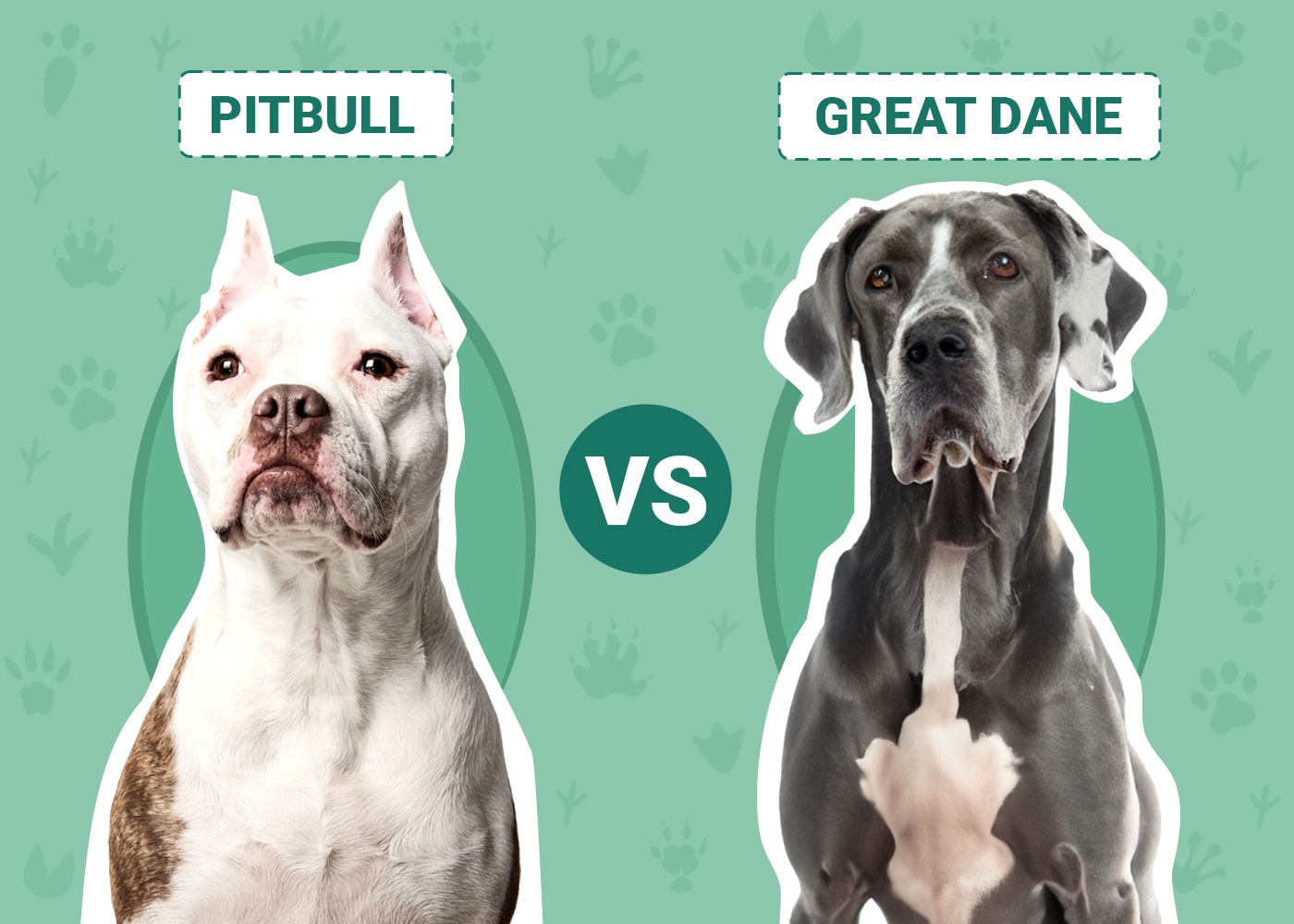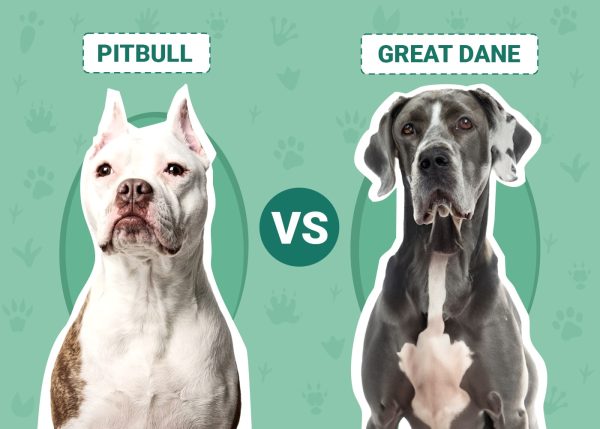If you have finally decided to bring a new addition into your home, you may have narrowed your search to a Great Dane or Pitbull. The final decision is a tough one since both breeds have wonderful personalities and would make excellent pets. Yes, both breeds are strong, protective, and loyal and would make wonderful companions. So, which one should you choose? While there are many similarities between the two breeds, there is one significant difference: the size of the Great Dane.
Below you can look at the comparison of the two breeds. You may find something that is a positive “yes” or a definite “no”, and that will help to finalize that decision. Rest assured, however, that whatever you decide, a Pitbull or a Great Dane, you have chosen a friend for life!
Visual Differences

At a Glance
- Average height (adult): 17–19 inches
- Average weight (adult): 55–70 lbs
- Lifespan: 11–13 years
- Exercise: 20 to 40 minutes per day
- Grooming needs: Regular brushing
- Family-friendly: Mostly
- Other pet-friendly: Rarely
- Trainability: Intelligent, stubborn, highly trainable
- Average height (adult): 28–32 inches
- Average weight (adult): 110–175 pounds
- Lifespan: 7–10 years
- Exercise: Daily 1.5 hours
- Grooming needs: Low
- Family-friendly: Yes
- Other pet-friendly: Often
- Trainability: Stubborn but easy to train
Pitbull Breed Overview
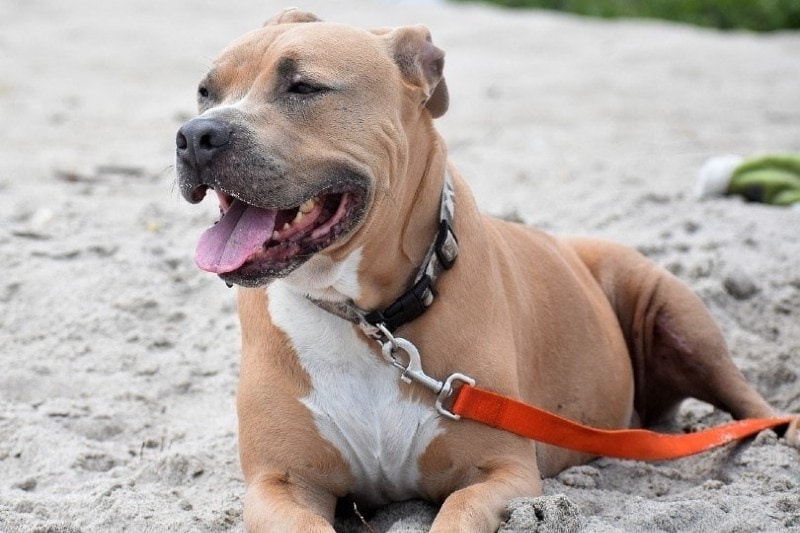
Personality / Character
The Pitbull breed, when trained properly and socialized, make wonderful family pets. They are fun-loving and playful with humans. This is not always the case with other dogs, so it is recommended that they be on a leash when they are going for a walk or at the dog park. They are fearless and can be stubborn at times, so they need a strong leader. Since they are such a large breed, they should be supervised with children since they can accidentally hurt them because of their size.
Training
When it comes to training a Pitbull, you will need to be patient and consistent. They are intelligent and sensitive so using positive reinforcement along with socialization and obedience at a young age will help to ensure a happy and playful pup. Walking your pup with a harness and introducing it to sights, sounds, other dogs, and new objects is an excellent way to start socializing the dog early on.
The Pitbull is a very energetic breed, so they need to be mentally stimulated and physically active to release that energy. They love to play tug-of-war, fetch, and run freely in a fenced-in yard. While they are not heavy barkers, they do tend to chase things if given the opportunity.
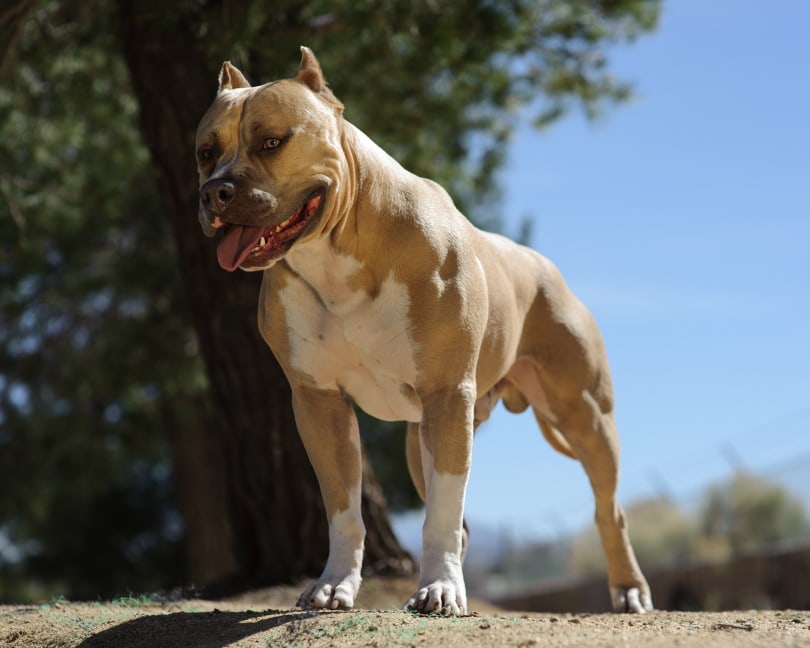
Grooming
When it comes to grooming your Pitbull, a weekly brushing, an occasional bath, brushing its teeth, and nail clipping should do the trick. There are two times a year when the shedding will increase, so you may find an increase in short hairs around the house.
Suitable For:
A Pitbull is sure to make an ideal pet for small families and owners that like to exercise and spend quality time with their pets. They require a pet parent that will be patient and consistent with training, obedience, and socialization.
They may not be a good choice for families with other dogs or who live in small apartments. They require room to run around and expel some energy, so a fenced-in yard would be awesome for the breed. They are loyal, loving, and trustworthy pets, given the time and patience they deserve.
- Playful and agile
- Loyal and affectionate
- Energetic and intelligent
- Minimal grooming needs
- Not usually pet friendly
- Stubborn
- Controversial breed
- Needs room to play and run
Great Dane Breed Overview
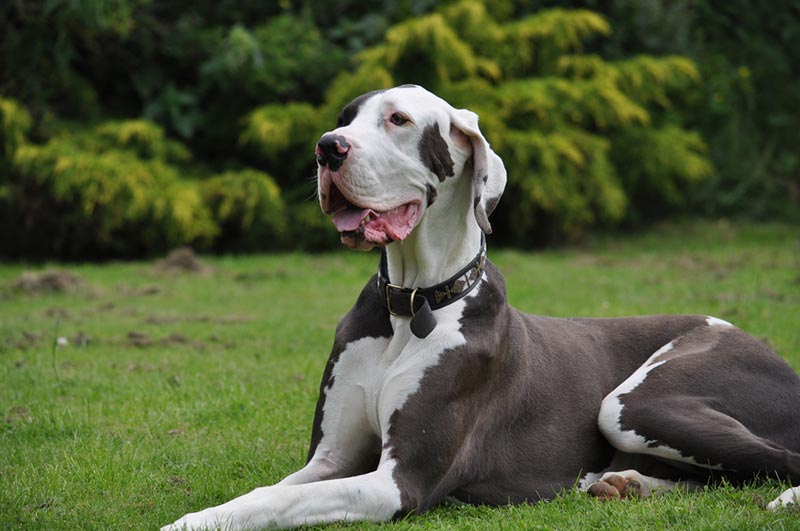
Personality / Character
Great Danes are known for their affection and loyalty to their families. They are a sweet breed but have a protective nature, but they will make nice with strangers once they get acquainted. They are patient with children but should be supervised with small ones because of their size. They could accidentally knock over or push a little one and cause them to get injured.
The breed is highly adaptable to living situations big and small, but they do not always get along with other dogs. Great Danes are sometimes referred to as the “Apollo of Dogs” because of their size, but they are also called the “Gentle Giant” because of their sweet nature.
Training
The Great Dane is big and powerful and can exhibit a stubborn streak. The breed is not for the weak, and it requires early socialization and obedience training. Great Danes may be stubborn, but they are also eager to please, which makes training a great bonding experience. Great Dane parents should begin training and socializing their pup at an early age and expose them to situations, people, and places so they can adjust to human and animal contact. They love human interaction and affection.
The amount of exercise you give your Great Dane will depend on its age. Hiking and jogging with your Dane should be avoided until age two, so it does not cause damage to its joints. Before age two, stick to walks at a healthy pace two or three times daily. The breed is also susceptible to bloat and should not engage in rigorous exercise at mealtimes.
Great Danes do well in obedience and agility competitions and love engaging in sporting events like flyball and tracking events.
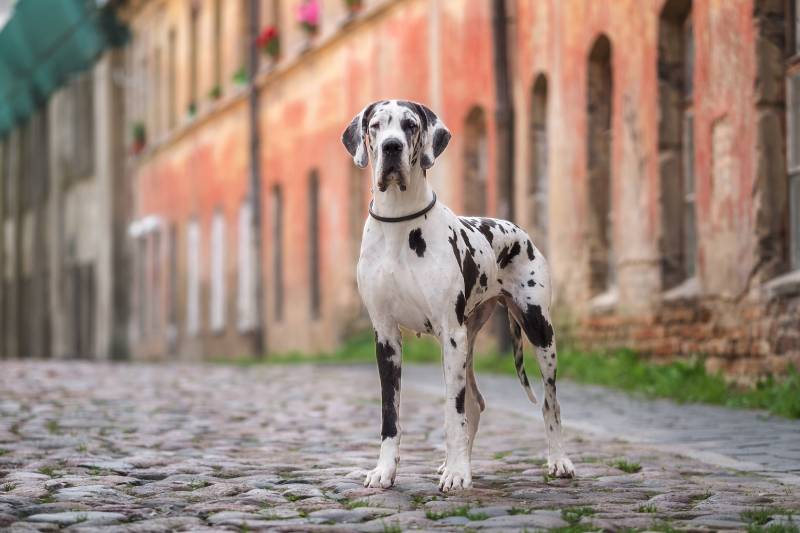
Grooming
Like Pitbulls, Great Danes do not require a lot of grooming. A weekly brushing, occasional bath, nail clipping, and tooth brushing should do it.
Suitable For:
Great Danes will do well in most family situations. However, you may want to wait to get a Great Dane if you live in a small apartment. The breed requires room to exercise and play. It is also important to remember that while the breed is calm and sweet, it is also large and powerful, so it should be supervised with small children and elderly adults.
Some Great Danes suffer from separation anxiety and do not do well in homes where they are left alone for long periods. They are also known to howl, which can be an issue if you are at work all day. They are ideal pets for stay-at-home pet owners or remote workers.
- Adapts to most environments
- Highly intelligent
- Highly trainable
- Low maintenance grooming
- Playful and affectionate
- Some suffer from anxiety
- Susceptible to bloat and joint problems
- Can be too large for small or elderly people
Both Pitbulls and Great Danes Require a Strong Leader
Both breeds can be strong-minded and stubborn, so they require a strong leader for obedience training and early socialization. Without the proper training, they can accidentally hurt you or someone else. For instance, if they get overly emotional, they can knock over a small child or drag someone if they pull too hard on their leash.
Both Breeds Have Excessive Health Issues
Since both breeds are larger in size, they are susceptible to quite a few health issues. They include joint problems, heart problems, and hip dysplasia. They are also prone to skin conditions and allergies. Great Danes do tend to suffer from more life-threatening conditions than Pitbulls which is evident in the shorter life span of a Great Dane. In fact, the lifespan of the gentle giant is 20% to 30% shorter than the lifespan of a Pitbull.
Which Breed Is Right for You?
When it comes to training, both the Pitbull and Great Dane are highly intelligent breeds that are easy to train. Both breeds require a strong leader since they can be stubborn at times and are not a good match for weak pet owners. Both dogs require space to run and play and are protective of their humans. However, Great Danes tend to be a bit more protective of family and home.
While there are many similarities between the two breeds, there is no question that the Great Dane is a bit larger than a Pit. Although Great Danes are giant lovers, their size can also be a risk to small children and elderly adults.
Whether you choose a Great Dane or a Pitbull, you will be lucky to have an affectionate but protective dog that will love its family for life.
Related Reads:
- Belgian Malinois vs. Pitbull: Notable Differences (With Pictures)
- Mini Saint Bernard (Cocker Spaniel & Saint Bernard Mix)
Featured Image Credit: Top – Lunja, Shutterstock | Bottom – BIGANDT.COM, Shutterstock

